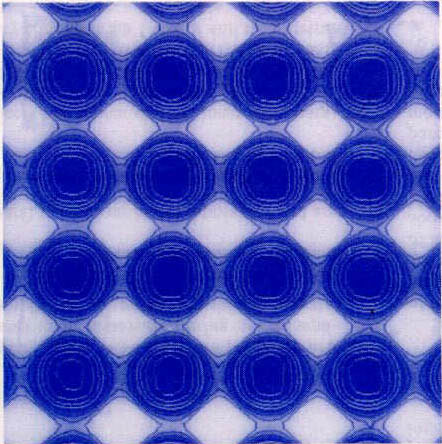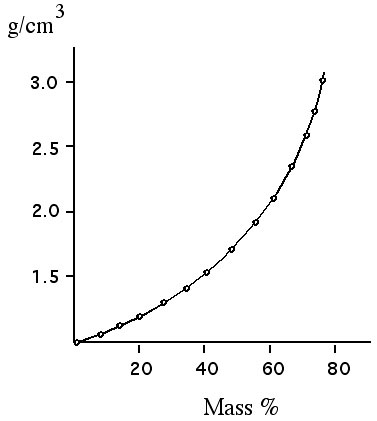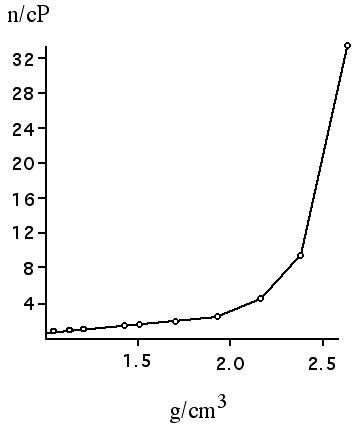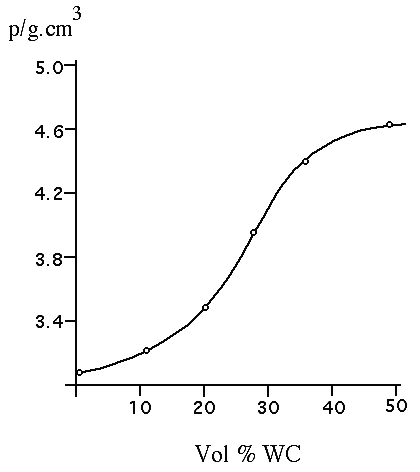pH range of sodium polytungstate
Density Relationship - SPT and Tungsten Carbide
Sodium Polytungsteate (SPT) is the generic name for the compound here involved: The specific compound involved is sodium metatungstate Na6(H2W12O40), which is a spherical molecule having 40 oxygen atoms on its outer shell, 12 tungsten atoms in tetrahedal configurations in an inner shell and 2 hydrogen atoms in the center, all surrounded by 6 sodium cations.

Computer enhanced 10 million enlargement of 16 polytungstate anions (H2W12O40). Actual size is 1 nm or 10 A diameter of the individual spherical molecule.
The analytical data is:
WO3 (tungsten trioxide) = 86.66%; Na (sodium) = 4.50 % H2O (water) = 8.84%
Sodium Polytungstate contain only a very low concentration of Carbon and has a low viscosity at high concentration. The solution of the white crystalline powder has a adjustable density from 1.0 to 3.1 g/ml. Ph-scale is approximate 3 at 4000 g/l water by 20°C. Note that SPT solution is stable in the pH-range 2-4. Please see Material Safety Data Sheet for further information.
The sodium polytungstate molecule is an aggregate of twelve monomeric units, with a molar mass of 1986 g/mol. This substance is freely soluble in water, the resulting solutions exhibiting neutrality although the molecule is also stable over a wide pH range. At room temperature (25 °C), the sodium polytungstate mass fraction of an aqueous saturated solution is 0.8.
The compound also has a tendency to supersaturation, a property which is of importance when density measurments are carried out with highly concentrated polytungstate solutions (important for the separation of minerals of differing densities).
The agent can have a density of up to 3.1 g/ml and has a low viscosity at high concentrations. The viscosity increases only insignificantly up to a density of about 2.5 g/ml. Accordingly also separations in the fine grain range are possible within shorter periods.
In the case of separation of water-insoluble solid mixtures of different densities, the densities of the solutions of the polytungstate can be increased up to 4.6 g/ml by adding to the solutions high density materials such as tungsten carbide of suitable grain size so as to form a suspension.
Trace elements:
As < 5ppm*; Bi < 2ppm; C < 40ppm; Co < 1ppm; Cu < 1ppm; Fe < 1ppm; Mn < 1ppm;
Mo < 2ppm; Nb < 6ppm; Ni < 1ppm; P = 8ppm; Pb < 1ppm; Sb = 2ppm;
Si = 17ppm; Sn = 7ppm; Sr < 1ppm; Ta < 1ppm; U < 10ppm;
*ppm = parts per million
NOTE: The trace elements can be removed quantitatively from the separated goods by a few washings with water.
Depending on concentration of sodium polytungstate the pH range is between 2 and 3.
Sodium Polytungstate is stable between the pH-range 2 and 4.
The density of aqueous sodium polytungstate solution as a function of the mass portion at 77°F 25°C.

The viscosity of aqueous sodium polytungstate solution as a function of density portion at 77°F (25°C).

Density of a heterogenous mixture of aqueous sodium polytungstate solution and tungsten carbide as a function of the solid material volume portion starting from a saturated aqueous sodium polytungstate solution
